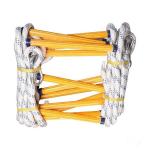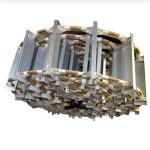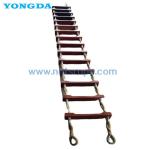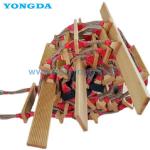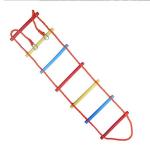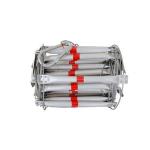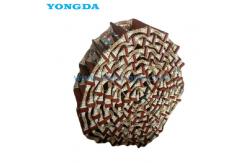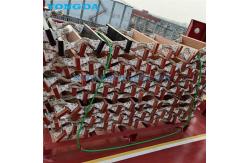ISO 5489-2008 Ship's Embarkation Rope Ladder
Description:
ISO5489-2008 Ship's Embarkation Rope Ladder is the equipment used
for getting on and off ships. Design & manufacture latest
Standard ISO 5489-2008 .For this essential requirement, all ships
are equipped with multiple numbers of what is known as embarkation ladders. They are nothing but foldable ladders that can hang from any
deck (especially the main or exposed deck) along the hull side and
enable the person to embark and disembark to and from the vessel.
It is also been used for crews to embark when anchoring. Light
weight, sate, used widely for various ship.
Main Technical Specification: - Technical Standard: (EU)2020/1170,item NO.MED/1.29.SOLAS 74 as
amended, Reg. III/4.III/11,III/34&X/3,LSA code,2000,HSC code 8
and IMO MSC.1/Circ 1285
- Type: Embarkation ladder, flat steps, rope seizing;
- Steps Number: 19-77, Customized;
- Length: 6000 to 25000mm, Customized;
- Material:
- Wooden part: Hardwood (e.g.: ash, oak, elm, beech, teak or apitong)
free from knots
- Side rope: Mildew-resistant manila rope or thermoset polyester rope
with a polypropylene core of a color that contrasts with the
polyester.
- Metallic materials: Metal fastener corrosion-resistant, Ferrous
metal coated, Stainless steel part at least 316, Aluminum part 5254
or 5652 alloy
- Classification Certificates: Type Approval, EC MED Type Approval
Etc.
- Making: In accordance with ISO5489:2008(E), Sec 7, the MED mark of
conformity and USCG approval number if applicable
- Application: Ship's embarkation and disembarkation
Test of ISO5489-2008 Ship's Embarkation Rope Ladder
| Test | Item to be tested | Test procedure | Acceptance criteria | Visual
examination | Fully assembled ladder. | Compare lo construction requirements In Clause 4, and the
manufacturer’s drawings. | The ladder shall comply with the construction requirements in
Clause 4, and be constructed in accordance with the manufacturer’s
drawings | | Step flexibility | Six steps, which shall include at least one of each different type,
including replacement steps, if different from steps used in the
ladders original construction. | Place each step on a pair of Supports located where the side ropes
would normally pass through the step. Apply a static load uniformly
for a period of at least 1 min over a 100mm wide contact area at
the center of the step. The load shall be 3,0 kN | Deflection at the center of the step shall not exceed 25 mm under
load There shall be no residual deflection after the load is
removed and the step is allowed to recover. | | Step fricton | One step of each different
material of construction and
step surface design One reference step constructed
of clean oak 115mn wide and 480 mm long
The step surface shall have
groove 3mm wide,3mm deep
and 15 mm apart. The grooves shall run parallel to each other and
parallel to the long edge of the step
One metal hook of a mass between 1.5 kg and 3.0 kg
The metal block shall have a flat surface no more than 100 mm wide
by 135 mm long. The flat surface shall have leather or composition
shoe-sole material attached to it. | Set the reference step in a level
position. Place the metal block
at the centre of the stepping surface of the reference step, and
with the longer edge of the metal block running across the
reference step over both edges Slowly raise one edge of the step
with the metal block on it. Measure the angle at which the block
begin to slide.
Repeat the procedure with the standard reference step and the block
under water.
Repeat the procedure in both dry and wet conditions using each
different ladder step. | The angles at which the block
begins la slide on the dry and
wet embarkation ladder step
shall be greater than or equal to
the corresponding angles measured for the standard reference step. | Step surface
durability | One step of each different
material of construction and
step surface design.
A metal block of the type described under the step friction test
arranged to enable a vertical load of 380 N to be applied to it as
it slides back and forth over the step under test | secure the Step in a horizontal position, with the loaded block
resting on it. Move the block back and forth from one end of the
step surface to the other and back In the same line, for a total of
1500 cycles.
Repeat the step friction test on the worn step in both dry and wet
conditions, making sure the sliding block is resting completely on
the worn surface
of the step | The angles at which the block
begins to slide on the dry and
wet embarkation ladder step
shall be greater than or equal to
the corresponding angle
measured for he standard
reference step. | Ladder and step
attachment
strength | Fully assembled ladder of
longest length e be approved | Suspend the ladder vertically, hanging to its full length or extend
the ladder to its full length on a horizontal surface, with the top
end of the ladder secured using its own attachments; Apply static
load of 8.8 Kn widely distributed over the bottom step for a period
of at least 1 min, So that the load is applied evenly between the
side ropes through the step attachment fittings. Repeat the
procedure at five different steps, except that the ladder is not
required to be hanging at full length and only the step under test,
its side rope attachments and the side rope immediately above the
step attachment fittings are required to be subjected to the load | Steps shall not break or crack
Attachments between any step
and a side rope shall not loosen
or break
Side ropes shall not sustain any
observable damage, elongation
or deformation that remains
after the test loads is removed | | Unrolling | Fully assembled ladder of longest length to be approved | Attach the rolled-up ladder lo anchoring fixtures in a place away
from any wall or structure that would prevent it from falling
freely, and where it can hang vertically. Allow the ladder to
unroll freely. | The steps and attachments shall
not cracked ,broken loosened.
The ladder shall not sustain damage that would make it unsafe to
use. |
Details of ISO5489-2008 Ship's Embarkation Rope Ladder
Products of ISO5489-2008 Ship's Embarkation Rope Ladder
FAQ:
Q0: Are you a factory or trading company?
A0: We are a professional manufacturer for synthetic rope, rope
net, rope ladders and relevant etc. We also trade steel wire rope
and etc.
Q1: What is your terms of packing?
A1: We use synthetic bags for package. We can pack the goods in
your brand after your approval.
Q2: What is your terms of payment?
A2: T/T & LC.
Q3: What is your terms of delivery?
A3: EXW, FOB, CFR, CIF, DDU.
Q4: How about your delivery time?
A4: Generally, it will take 1 to 7 days after receiving payment.
The specific delivery time depends on the products and the
quantity.
Q5: Can you produce according to the samples?
A5: Yes, we can produce as your samples or drawings.
Q6: What is your sample policy?
A6: We can supply the sample it is stock available, while courier
cost and sample cost (it depends) are to be covered by buyer. It
will be refunded for next time order.
Q7: Do you test all your goods before delivery?
A7: We test our finished products & raw material by bathes, and
as requirement by third party case by case |
